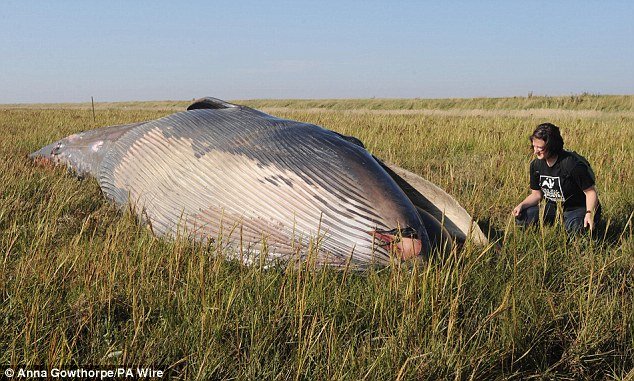
A rare breed of whale was found dead 800 yards (730 meters) from the shoreline in the Humber Estuary, UK.
The 33feet (10 meters) mammal, thought to be a Sei whale, was discovered in salt marshes on the north bank of the River Humber.
It is also thought that the whale became stranded in shallow waters, rolled over onto its blowhole and died, before the tide retreated and left it behind, near the village of Skeffling.
The Yorkshire Wildlife Trust has spent the summer monitoring the area due to an increase in whale sighting and activity.

Conservationists believe the increase in the number of strandings could be explained by a change in sea currents bringing colder streams of Arctic water into the North Sea and with them whales that would not normally pass so close to the UK shoreline.
Sea experts who examined the animal said they are 95% certain it is a female Sei whale and say the huge sea creature could simply have been looking for food when the tide turned.
Kirsten Smith, North Seas Living Seas manager at Yorkshire Wildlife Trust, said:
“The area where the whale was found is salt marsh, which is still connected to the sea.
“With the high tide the whale probably got carried up on to the salt marsh, got pushed further in shore and then got stuck when the tide went out.
“The salt marsh is one of several components of the Humber Estuary, and is further in than the mud flats and sand components.
“Sometimes whales come into the shallow water looking for food and get stuck.
“It can be illness or confusion in individual animals, but for it to happen twice in the area, and with reports of another whale nearby now, that could be more than just coincidence.”

The Yorkshire Wildlife Trust has launched a campaign called Petition Fish to encourage to Government to monitor more closely the changes in British marine life.
A spokesman for the Environment Agency said that the whale is likely to have found herself so far in as today marked the day of the highest and lowest tide of the year.
Humber Estuary Services estimate that water levels at Albert Dock, near Hull went as high as 9.5 m by 7:00 a.m. today, and went down to 1.3 m by 2:00 p.m.
The whale, found at 2.30 p.m. last Friday, is the latest of a number to have died in the Humber estuary.
Andy Gibson, of the Yorkshire Wildlife Trust, added that Sei whale strandings were very rare with only three in UK waters in the last 20 years.

Andy Gibson said: “It was in shallow water of 4ft -5ft, making contact with the bottom. When it gets in that situation it rolls onto its side and it can cover its blow hole. It is sad but we will be able to learn a lot from it.”
Earlier this month, a young Fin whale – a relative of the Sei – became stranded at Immingham, North East Lincolnshire, and washed up dead near Spurn Point.
Another dead whale was spotted in the river mouth in the last few days but has yet to wash ashore.
The Yorkshire Wildlife Trust has reported a rise in whale sightings this year but no-one is sure why the mammals are making their way to the North Sea.
Over the summer, a pod of around ten Minke whales were regularly spotted off the North Yorkshire coast between Whitby and Scarborough.